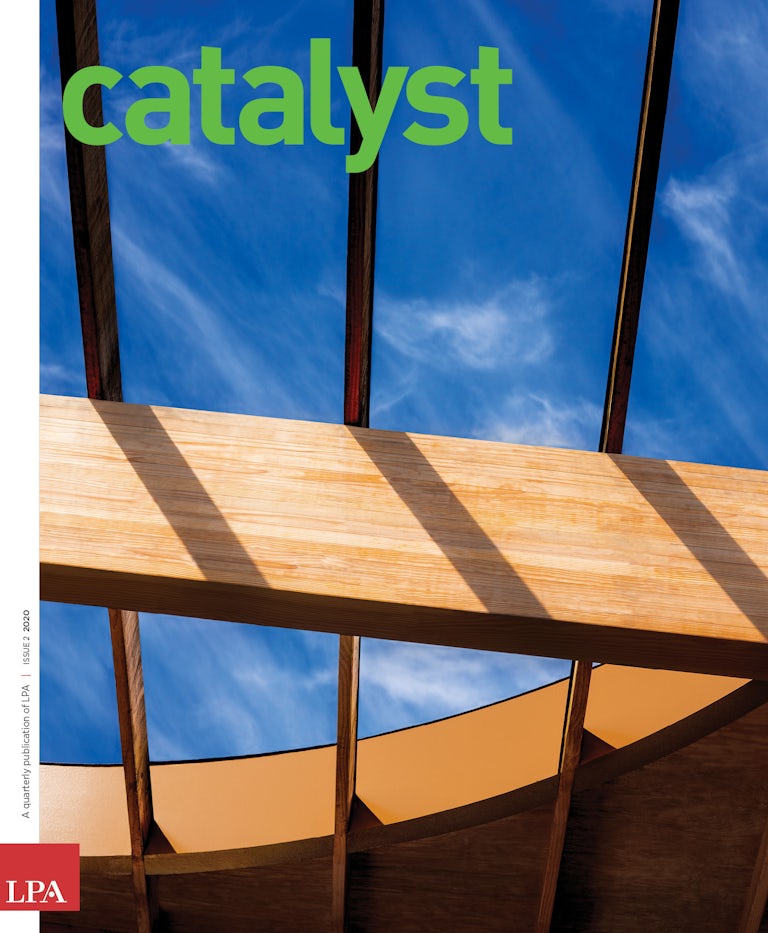In 2008, LPA completed the 9,000-square-foot headquarters for the Environmental Nature Center (ENC), which is focused on providing environmental education through hands-on experiences with nature. Through simple, cost-effective design strategies, the center was certified as the first LEED Platinum building in the region and has operated at net zero since it opened, offering the California coastal community of Newport Beach a living, operating model for sustainability.
Last September, the ENC added a 10,380-square-foot preschool, designed to deliver nature-based education for children ages 2½ to 5. The preschool expands on the sustainability focus of the original nature center and adds a variety of indoor-outdoor play and education areas, developed in collaboration with educators, the community and the ENC. The preschool is the second LEED Platinum building on the 4.7-acre campus. It operates at net zero and complements the existing facility while seamlessly blending indoor and outdoor learning environments designed to provide children with an intuitive understanding of the natural world.
Turning Nature Into a Teaching Tool
The LEED-Platinum, net-zero Environmental Nature Center Preschool in Newport Beach, California, delivers nature-based education for young children and initiates a life-long relationship with the environment.

The ENC sits on 4.7 acres on a bluff in a suburban community, a mile inland from the Pacific Ocean. To take advantage of the coastal climate, the original building and the preschool were oriented to allow for natural ventilation, significantly reducing initial and long-term operating costs. Neither building uses a conventional HVAC system. Low-energy ceiling fans enhance air movement when needed. A radiant floor heating system provides low energy, mild heating as required.
“It was extremely important for the design to mirror our sensibilities on sustainability and energy efficiency,” said Bo Glover, executive director of the ENC.
The preschool is a secure extension of the original facility. All the classrooms open to a central courtyard, which connects to the nature learning center through a covered breezeway. Each of the classrooms is open and flexible, with movable walls that allow indoor spaces to blend with the outdoors. All the circulation happens outside. “The intent is that education will not only happen between those four walls,” says LPA Design Director Rick D’Amato. “It is meant to flow between the interior and the exterior.”



Different learning areas offer different themes. Boulders, logs and tree stumps define open-air learning spaces. The different zones are connected with a tricycle path. An organic garden next to a kitchen provides teaching opportunities and the opportunity for students to prepare their own food. Every space is designed to spark “creativity, cooperative learning and imagination,” Glover says. The goal was to develop a facility where space could be activated and tied to the learning mission, he says. “We wanted to be an example of how schools should be built to achieve the educational goals.”

“The intent is that education will not only happen between those four walls,” says LPA Design Director Rick D’Amato. “It is meant to flow between the interior and the exterior.”
The preschool was developed through an integrated design process which included the firm’s architects, landscape architects and interior designers, taking a holistic approach to addressing the educational spaces, as well as energy and water conservation. “We were able to seamlessly work together around this whole idea of a nature preschool and learning through nature,” D’Amato says.

The landscape architects worked closely with ENC’s educators and the community to develop the grounds and blend the outdoor spaces with the school’s mission. All of the plants across the ENC campus are native to California and do not require irrigation. There are three distinct zones, each named after a national park—Sequoia, Joshua Tree and Yosemite. All the rock and natural elements are movable, allowing kids to create their own environments. “Kids learn by moving things around,” says LPA landscape architect Danielle Cleveland. “We wanted to give them as much framework as we could, while still allowing that creativity and flexibility.”
“It was extremely important for the design to mirror our sensibilities on sustainability and energy efficiency,” said Bo Glover, executive director of the ENC.

Energy efficiency and water conservation are baked into every element of the facility. The butterfly-shaped roof opens the classrooms to natural light and supports a 32kw array of photovoltaic panels, which are designed to provide 105 percent of the net energy for the preschool’s electrical needs. Rainwater is treated as an educational tool. Single-sloped roofs capture the water, which is channeled through rock basins to bioswales, where the water is naturally treated and clarified by plant materials before leaving the site to recharge aquifers.

The preschool is pursuing the Living Building Challenge’s Petal Certification, making it one of the first projects in the region to target both the high level of sustainability and the healthy environment standard.















